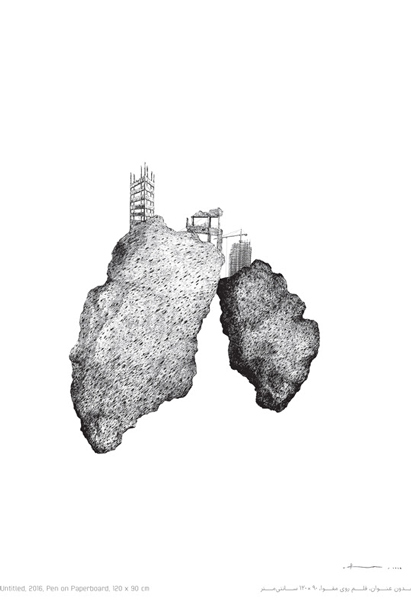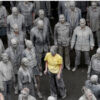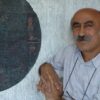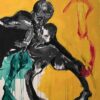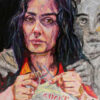کـیـــــــــــــان وطـــــــــــــن
«تهـران / فصـل دوم / نقطـهی گریــز»
بیست و پنج تیر تا شانزده مرداد نود و پنج
گشایش: چهار تا هشت عصر
سایــــــر روزهـــــا: یازده تـا هفت عصر
دســــتان+۲ یکشنبه هــــا تعطـــیل اســت
Kian Vatan
«Tehran / Second Season
Evasion Point»
۱۵ July – ۶ Aug 2016 / ۴ to 8 pm
Other Days: 11 am to 7 pm
Dastan+2 is closed on Sundays.
دستان +۲ برگزاری نمایشگاه آثار کیان وطن با عنوان «تهران / فصل دوم / نقطهی گریز» را اعلام میکند. این نمایشگاه در روز ۲۵ تیر ۱۳۹۵ افتتاح میشود و تا تاریخ ۱۶ مرداد ادامه خواهد داشت.
کیان وطن (م. ۱۳۵۵، تهران) هنرمند طراح پرکار و خستگیناپذیر، سالهاست که در مجادله با جاذبهها و دافعههای تهران، این شهر و تاریخش را میپاید، میکشد و میپژوهد. مهمترین بنمایههای طراحیهای او در سالهای اخیر تاریخ معماری، طراحی شهری و تغییرات شهرسازی تهران بوده است. حاصل این تمرکز، سهگانهی گستردهی «تهران» بوده که سومین بخش آن با عنوان «تهران / فصل دوم / نقطهی گریز» در این نمایشگاه ارائه شده است. آثار کیان وطن تاکنون در هشت نمایشگاه انفرادی و چندین نمایشگاه گروهی به نمایش درآمدهاند. این اولین نمایشگاه انفرادی آثار این هنرمند در دستان است. آثار او قبل از این در یک نمایشگاه گروهی در زیرزمین دستان ارائه شده بود.
بارزترین وجه مجموعهی «تهران» کیان وطن، نگرش تاریخی او به تغییرات شهری تهران از نگاهی معمارانه بهسوی آشوبی در لایههای مختلف شهرسازی است. رویکرد این مجموعه صرفاً مطالعه از طریق منابع تاریخی و پژوهشی نیست، بلکه اساس کار هنرمند تجربهی مستقیم، پیادهروی، مشاهده و تمرین بوده، بهطوریکه خود را با روحیهی معماریها همراه کرده و هم در نوستالژیای مالیخولیایی اجتنابناپذیر آنها و هم با پیکرهای نیمهجانشان زندگی کرده است.
«تهران / مقدمه»، تاریخ تهران را از اواخر دوران قاجار تا اواسط دورهی پهلوی اول، با مطالعه روی معماری لالهزار، باغ اتحادیه و باقیماندههای معماری این دوره در تهران معاصر، نمایش میدهد. «تهران / فصل اول / شبانه»، که عنوانش را از آلبوم «شبانه»ی فرهاد مهراد وام گرفته، معماری و شرایط اجتماعی تهران در دوران پهلوی دوم تا دورهی انقلاب را نمایش میدهد — فضاهایی سیاه و سفید و خلوت، در سکون و سکوت، و فریادهای یکبارهی شبانه.
«تهران / فصل دوم / نقطهی گریز»، جدال تهران با هویت را در دوران معاصر نمایش میدهد — شهرسازی در دورهی بیقاعدهی امروز برای سالها اهمیت خود را از دست میدهد و عناصری بیهویت و بیجا یکباره در فضاهایی درمیان یا دور از محیط متعارف شهر قد میکشند. داربستها برپا و بنایی ساخته میشود، انسجام از بین میرود و هر بنا تبدیل به شیئی سرگشته درمیان هاشورهای متراکم شهر میشود.
امید روحانی دربارهی «فصل اول» نوشته بود که «تهران کیان وطن، در نمایشگاههای قبلیاش، هنوز تهرانی با اندک اصالتی بود. بناهایی آشنا از هویتی کهن و شناختهشده، از اصالتی که هنوز بارقههایش در لابهلای خطوط تیره و کدر، تاشهای سیاه و سفید و هاشورهای غلیط و زیرلایههای رنگ سیاه و دودی و انبوهی کدری و سیاهی دستکم قابل تشخیص بود… اما این تهران جدید هیچچیز از اصالت گذشته و حتی از هویت چند دههی اخیر هم ندارد. خالی و سیاه است، تودهای ازشکلافتاده و بیرنگ و سیاه و قیرگونه.» همین رویکرد و مسیر در «فصل دوم» هم جاری شده، بهطوریکه اینبار، هویت تهران درست آنچیزیست که نیست.
Dastan +2 is pleased to announce the opening of “Tehran / Chapter Two / Evasion Point” on July 15, 2016. The exhibition will be open for public viewing through August 6.
Kian Vatan (b. 1976, Tehran, Iran), a prolific drawing artist, has been monitoring, drawing and studying the city of Tehran and its history in an effort against its gravities and repelling forces. The most prominent themes in his drawings in the recent years are the architectural history, urban design and urban changes of Tehran. His focus on these has resulted in the vast world of the “Tehran” trilogy, of which the third installment, “Tehran / Chapter Two / Evasion Point” is on display in this exhibition. Kian Vatan’s work has been featured in eight solo and numerous group exhibitions. This is his first solo exhibition at Dastan. His work has been previously shown in a group exhibition at Dastan’s Basement.
The most significant aspect of Kian Vatan’s “Tehran” is his historical approach to urban changes of Tehran from an architectural paint of view towards a chaos in different urban layers. The approach in this series is not merely dependent on studies using academic and historical sources, but the artist has relied on direct experience, long walks, viewing and practice, so as to arm himself with the spirit of the architecture, delving into their inevitable melancholic nostalgia and living with their half-alive bodies.
“Tehran / Introduction” dealt with the history of Tehran from the late Qajar period (about 1900s) to the mid First Pahlavi era (1930s), studying on the architecture of Laleh-Zar, Etehadieh Garden and what had been left of the architecture of that period in contemporary Tehran. “Tehran / Chapter One / Nightly” which had taken its name from Farhad Mehrad’s album “Nightly”, showed the architecture and the social conditions of Tehran during the Second Pahlavi (1941) to the 1979 Iranian revolution — black and white and quiet spaces in suspense, and sudden cries in the air.
“Tehran / Chapter Two / Evasion Point”, shows Tehran’s conflict with identity in contemporary times — urban planning loses its importance in today’s Iran for years and identity-less and out-of-place elements suddenly appear at in-between spaces or places outside of the defined border of the city. The scaffoldings are raised and a building is built, cohesion is ruined and each building becomes a lost object in the dense crosshatches of the city.
Omid Rouhani wrote about “Chapter One” that “Kian Vatan’s Tehran, in his previous exhibitions, was still a Tehran with some originality. Familiar buildings from an ancient and known identity, from an origin that its remains were to be distinguish between the dark and vague lines, black and white touches and deep crosshatches and under-layers of black paint and haziness… but this new Tehran has nothing left from its genuineness or even its identity of the recent decades. It is empty and black, a formless, colorless, dark and tar-like mass.” This very approach is still flowing in “Chapter Two”, and this time, what remains of Tehran’s identity is exactly what is missing.


